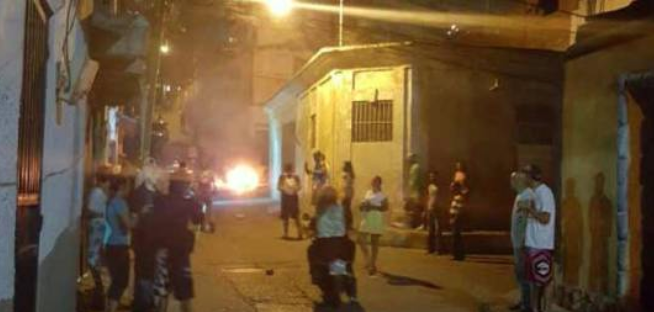The recent protests organized by the Venezuelan opposition have generated an unusual scenario in the lower income areas of Caracas. The so-called “Mother of all Marches” on April 19 brought with it a restless night of protests and riots in several areas of Caracas’s west side, an area that has been solidly pro-government until recently.
In Antímano, the neighborhood in which I have lived my whole life, the commotion began with an energetic “cacerolazo” (pot-banging protest) accompanied by yells and chants. “Out Maduro” (Fuera Maduro); “No more dictatorship” (No más dictadura). And this was only the beginning.
“Suddenly, it was as if the people were no longer afraid to step out to the street and protest. Before, it would have been crazy to do so in this part of the city. I was shocked when the people started to organize to block the street,” says Freddy Herrera, a 46 year-old street vendor in Santa Elena.
Residents of this and other lower income areas of Caracas, emboldened by the tumult and repression that they were subjected to during the opposition’s demonstration on Wednesday decided to block the main access routes to their neighborhoods by setting up improvised barricades of trash and lighting them on fire.
Freddy is right: a few years ago, it would have been impossible to see someone protesting in such an energetic way against the government in Antímano for two reasons. First because it is one of the areas where the socialist project of the late President Hugo Chavez had strong electoral support. Second, it is an area where radical groups of Chavista supporters known as “colectivos” live and operate.
Traditionally, it was very easy for candidates of the government to win in this neighborhood given its broad Chavista base. However, the legislative elections of 2015 showed a reversal in the situation, triggered almost entirely by the current economic crisis that acutely affects the residents of this and other “barriadas,” which constitute the majority of Caracas’ population.
With the passing of time, President Nicolas Maduro’s inability to respond to the multiple demands of this sector and the recent revival of the massive protests by the opposition have turned the slums of Caracas into places where violent protests could potentially break out due to the rising levels of frustration.
The night of April 19 was just a small demonstration of this. There were attempts at looting in several businesses of the central sector. There were several explosions and even armored vehicles in the main access routes to the barriada. Even so, the protest was dispersed quickly because of the joint action of the police and the colectivos.
“As soon as problems started I saw how the colectivos started to arrive. People were trying to loot the pharmacy, and the colectivos arrived shooting in the air and screaming,” recalls Keyber Morales (24), who lives in the central zone of Antímano. “The police also saw all this and helped further, telling everyone in the streets to get into their homes.”
Even though the government’s mechanisms of repression seem to be very effective in controlling spontaneous popular protests, controlling an entire city is becoming increasingly difficult, especially in a country where social tension resulting from widespread shortages has no clear escape valve.
Violent protests in the neighborhoods of El Valle, El Paraiso and Palo Verde followed the events in Antímano. This fact marks another major departure from the usual opposition protests localized exclusively in the east of Caracas.
“As long as the government doesn’t improve things the people will keep on protesting, this is obvious. People are tired, and they want to get rid of Maduro however they can to see if something changes. And [the government] should pay more attention to this because now it is the ‘cerros’ that are pissed off and causing problems [formando peo],” says an Antímano resident who prefers not to be identified.
Translated by Annelies Smilde



